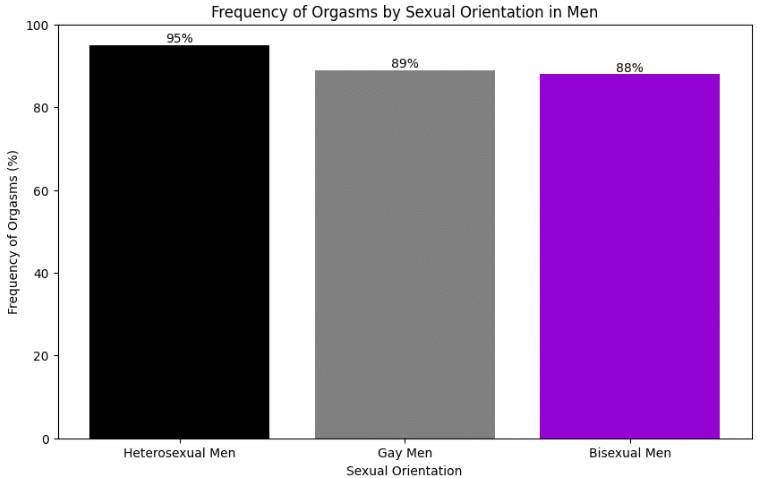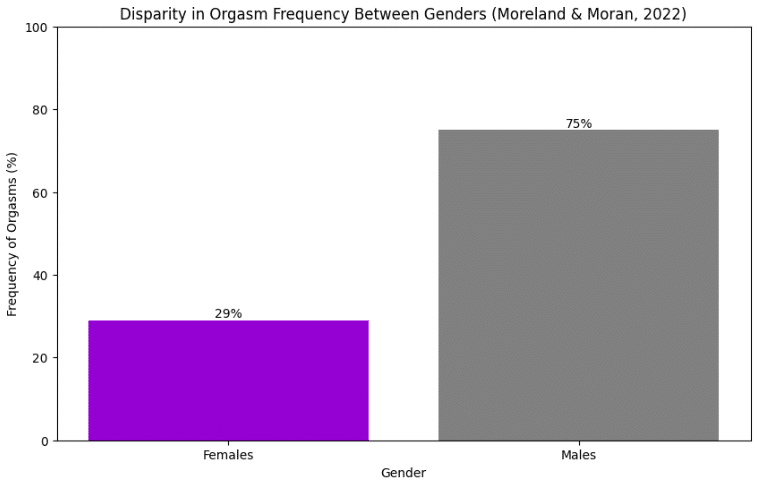Understanding the dynamics of male orgasms is crucial in the realm of sexual health research. Orgasms are not only a vital aspect of sexual satisfaction but also contribute significantly to psychological and relational well-being.
This article delves into the intricate statistics surrounding male orgasms, exploring how factors such as sexual orientation, perception of orgasm occurrence, and sexual practices influence orgasmic frequency.
Drawing on recent studies, we uncover the varied experiences of heterosexual, gay, and bisexual men, the impact of sexual esteem and perceptions on orgasm occurrence, and the broader implications of these findings for sexual health education and therapy.
By examining the relationship between testosterone levels, sexual dysfunction, and male infertility, we aim to provide a comprehensive overview of male sexual health, highlighting the importance of continued research and education in this field.
Orgasm frequency by sexual orientation
A fascinating study by Frederick et al. (2018) reveals significant differences in orgasm frequency among men of different sexual orientations during sexual intimacy. Heterosexual men report the highest frequency of orgasms at 95%, followed closely by gay men at 89%, and bisexual men at 88%.
These statistics not only shed light on the sexual experiences of men across the spectrum of sexual orientations but also raise questions about the factors contributing to these differences.
The reasons behind the variation in orgasm frequency among heterosexual, gay, and bisexual men could be multifaceted, encompassing psychological, physiological, and sociocultural factors. For instance, societal norms and expectations, levels of sexual communication, and comfort with sexual orientation may all play roles.
Additionally, the dynamics of sexual encounters, including partner sexual behavior and the inclusion of specific sexual practices, could influence orgasm frequency.
This discrepancy highlights the need for a more nuanced understanding of sexual health that considers the diverse experiences of men based on their sexual orientation.
Perception of Orgasm Occurrence
The study conducted by Garcia et al. (2014) further complicates our understanding of orgasms among men by examining the occurrence rate of orgasms among single men. Interestingly, the study finds no significant variation in orgasm occurrence by sexual orientation, with heterosexual men at 85.5%, gay men at 84.7%, and bisexual men at 77.6%.
This suggests that, contrary to what one might expect, sexual orientation does not drastically impact the likelihood of experiencing an orgasm for men.
These findings imply that factors beyond sexual orientation contribute to the orgasmic experiences of men. It suggests that individual differences, such as sexual preferences, practices, and the quality of sexual encounters, may be more influential in determining orgasm occurrence.
This challenges common perceptions and emphasizes the complexity of human sexuality, encouraging a broader and more inclusive approach to sexual health research and education.
Influence on Sexual Esteem
The research conducted by Chadwick & van Anders in 2017 provides intriguing insights into the psychological aspects of male orgasms, specifically regarding men’s sexual esteem and feelings of masculinity. Their findings suggest that men’s perceptions of their female partner’s orgasm during sexual encounters significantly influence their sexual esteem and sense of masculinity.
This association underscores the complex interplay between psychological well-being and sexual satisfaction, where the perceived sexual satisfaction of the partner becomes integral to one’s own sexual identity and esteem.
This dynamic can have profound implications for sexual relationships, highlighting the importance of communication and mutual satisfaction in sexual encounters. It suggests that men’s sexual confidence and feelings of adequacy are, to a large extent, contingent upon their perceptions of their partner’s pleasure.
It raises important considerations for sexual health practitioners and educators, who can address these perceptions in therapy and sexual health education to promote more fulfilling and mutually satisfying sexual relationships.
General Statistics on Human Sexuality
The disparity in orgasm frequency between genders is stark, as highlighted by a study from Moreland & Moran in 2022. Approximately 29% of females achieve orgasm during sexual encounters, in stark contrast to 75% of their male counterparts. This significant gender gap in orgasm frequency points to a broader issue within human sexuality, where physiological, psychological, and sociocultural factors converge to create differing sexual experiences for men and women.
The reasons behind this disparity are complex and multifaceted, ranging from differences in sexual anatomy and physiological responses to cultural and societal norms that shape sexual behaviors and expectations. Additionally, the inclusion of varied sexual practices and the level of sexual communication between partners play crucial roles in bridging this gap.
Understanding and addressing these factors is essential for improving sexual satisfaction and health outcomes for all individuals, regardless of gender.
Sexual Dysfunction Prevalence
Sexual dysfunctions, including orgasmic dysfunctions, are relatively common, affecting individuals across the spectrum of gender and sexuality. According to Spector & Carey (1990), the prevalence of inhibited male orgasm ranges from 4-10%, highlighting the variability and complexity of sexual dysfunctions.
These dysfunctions can significantly impact an individual’s sexual health and overall well-being, making it crucial to understand and address the underlying causes.
The variations in the prevalence of different types of sexual dysfunctions across genders underscore the need for gender-specific research and interventions.
For men, understanding the physiological, psychological, and relational factors contributing to sexual dysfunctions, including orgasmic dysfunction, is key to developing effective treatments and support mechanisms.
Sexual Practices and Orgasm Occurrence
A study on Australian adults by Richters et al. (2006) sheds light on the relationship between sexual practices and orgasm occurrence, revealing that men experienced orgasms in 95% of sexual encounters. This high likelihood of orgasm for men during sexual activities contrasts with the experiences of women, whose sexual satisfaction increased with the inclusion of more varied sexual practices, particularly cunnilingus.
These findings highlight the importance of diversity in sexual practices for enhancing sexual satisfaction for both men and women.
They suggest that expanding the repertoire of sexual activities can be beneficial in promoting more equitable and satisfying sexual experiences, underscoring the value of sexual exploration and communication between partners.
Testosterone Levels and Orgasmic Frequency
The study by Kraemer et al. (1976) examines the intricate relationship between plasma testosterone levels and orgasmic frequency in men, uncovering that higher levels of testosterone are associated with increased periods of sexual activity.
However, the direction of this relationship appears to vary across individuals, suggesting a complex interplay between hormonal levels and sexual behavior. This complexity indicates that while hormones like testosterone play a critical role in sexual function, their influence on orgasmic frequency and overall sexual satisfaction is not straightforward.
This variability underscores the importance of considering individual differences in understanding sexual health. The findings also suggest potential avenues for therapeutic interventions, where hormonal assessments and treatments could be tailored to address specific sexual dysfunctions.
However, it also cautions against oversimplifying the role of hormones in sexual health, advocating for a holistic approach that considers psychological and relational factors.
Sexual Dysfunction and Male Infertility
The interconnectedness between sexual function and reproductive health is highlighted in the research by Lotti & Maggi (2018), which shows that sexual dysfunction, including difficulties achieving orgasm, is frequently observed in men of reproductive age and can contribute to infertility in some cases.
This connection underscores the importance of comprehensive assessments in men presenting with infertility, as addressing underlying sexual dysfunctions can be crucial for improving reproductive outcomes.
This research emphasizes the need for a multidisciplinary approach to men’s sexual health, integrating the expertise of urologists, endocrinologists, and sexual health therapists. By recognizing the link between sexual dysfunction and infertility, healthcare providers can offer more effective treatments that address both sexual and reproductive health concerns, ultimately improving the quality of life for affected individuals.
Conclusion
The exploration of male orgasms through the lens of scientific research reveals a complex picture influenced by a myriad of factors, including sexual orientation, psychological perceptions, hormonal levels, and the presence of sexual dysfunctions.
The statistics and studies discussed underscore the diversity of male sexual experiences and the importance of addressing sexual health with a nuanced and comprehensive approach. As research in this area continues to evolve, both the scientific community and the public must remain open to new findings and perspectives.
Understanding and improving male sexual health requires ongoing education, empathy, and a commitment to addressing the needs of all individuals, regardless of their sexual orientation or experiences. By fostering an environment of open communication and support, we can hope to improve sexual satisfaction and well-being for men around the world.






